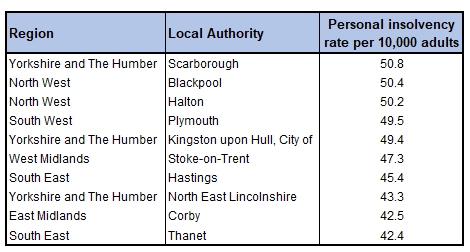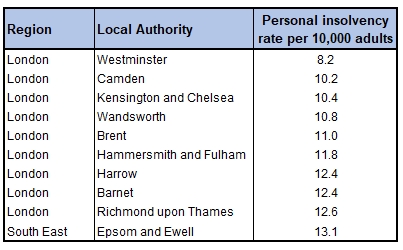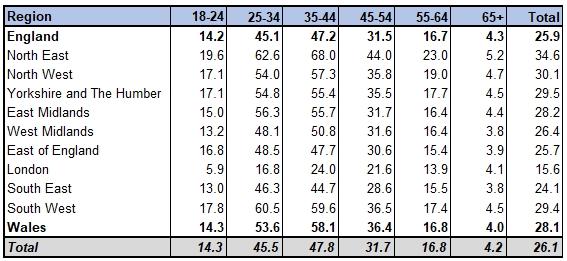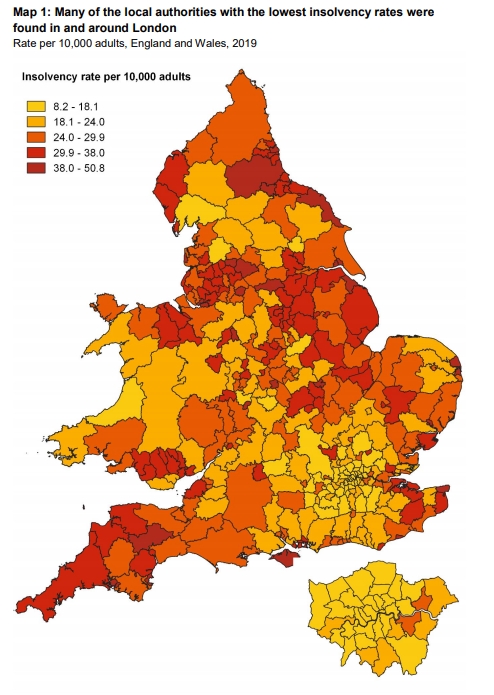
Pre-pandemic personal insolvencies set stage for current financial pain, figures show
11 December 2020
- The rate of personal insolvencies in England and Wales rose for the fourth year in a row in 2019, to 26.1 per 10,000 adults
- Women (27.8 per 10,000) had a higher personal insolvency rate than men (24.1 per 10,000)
- The North East was the region with the highest rate of personal insolvency in England and Wales, at 34.6 per 10,000 adults, while London had the lowest, at 15.6 per 10,000 adults.
Even before the pandemic hit the UK economy, many people were finding it hard to get by, with personal insolvencies highest among women, people living in coastal areas, and the North East, according to government figures analysed by insolvency trade body R3.
The personal insolvency demographic data for 2019 in England and Wales from the Insolvency Service show that the overall personal insolvency rate increased for the fourth year in a row, to 26.1 per 10,000 adult population, up 4% from 2018, and 22% from 2017.
Of the regions of England and Wales, the North East had the highest overall rate of personal insolvency, at 34.6 per 10,000 adults, while London had the lowest, at 15.6 per 10,000 adults. It is the 12th year in a row that the North East has had the highest personal insolvency rate of all regions in England and Wales.
The headline rate hides huge variations, however. Women aged 35-44 in the North East of England had the highest regional personal insolvency rate, with 75.4 per 10,000 adults - nearly three times the overall rate for England and Wales. By contrast, the lowest regional level of personal insolvencies was found among women aged 65+ living in the East of England, whose rate per 10,000 of 3.2 was over eight times lower than the England and Wales rate.
Christina Fitzgerald, Vice President of R3, commented:
"When the COVID-19 pandemic reached the UK, many people were already in a financially vulnerable position, as the 2019 personal insolvency figures show. The figures tend to follow patterns seen in previous years, with personal insolvencies concentrated in coastal areas, where work tends to be seasonal and low-paid; in post-industrial areas, where the retreat of industry has left many without work, or in unstable employment; and among women; who are much more likely than men to be single parents, and to be negatively financially affected by relationship breakdowns, among other factors.
"The pandemic's effect on many people's personal finances has been devastating: for a lot of people who were only just getting by before it came along, a subsequent COVID-related reduction in hours, job loss, or lack of childcare may easily have been enough to tip them into crisis. Even for those who were placed on furlough, 80% of their salary may not have been enough to manage on if they were already finding it difficult to cope.
"The hospitality industry has been particularly hard-hit, which will spell trouble for many seaside towns and resorts, which - as these figures demonstrate - were already struggling with high levels of debt among local populations.
"Personal insolvency processes do at least offer a way forward for people who cannot pay their bills, with the prospect of a fresh start once the procedure has ended. It can be hard to talk about debt problems, but opening up to a regulated and trustworthy advisor can be the start of a journey to financial stability."
Local Authority results show even greater disparities
Breaking the statistics down by Local Authority highlights the variations even further. Nine out of ten of the Local Authorities with the lowest rates of personal insolvency for all adults were in London, with the sole non-London LA being Epsom & Ewell, just on the capital city's borders.
By contrast, the ten Local Authorities with the highest rates were more geographically diverse, with three LAs in Yorkshire & the Humber (Scarborough, with the highest rate; Kingston upon Hull in fifth place; and North East Lincolnshire in eighth place), two in the North West (Blackpool in second and Halton in third place) and the South East (Hastings in seventh and Thanet in tenth place), and one each in the South West (Plymouth in fourth place), West Midlands (Stoke-on-Trent in sixth place), and the East Midlands (Corby in ninth place).
What links eight out of the ten Local Authority areas with the highest rates is their closeness to the sea, with all but Corby and Stoke-on-Trent in near proximity to the coastline.
Gender was another faultline: The personal insolvency rate for women was 15% higher than the male rate, at 27.8 per 10,000 women, against 24.1 for men.
Local Authorities with the highest personal insolvency rates, 2019

Source: R3/The Insolvency Service
Local Authorities with the lowest personal insolvency rates, 2019

Source: R3/The Insolvency Service
Personal insolvency rates by age and region, 2019

Source: R3/The Insolvency Service

Source: The Insolvency Service

- R3 Blog Member news, commentary and analysis from R3
- Policy & Research Insights into the economy and the insolvency and restructuring, and recommendations for reform
- Consultation Responses Our responses to Government consultations on insolvency and restructuring issues
R3 members can provide advice on a range of business and personal finance issues. To find an R3 member who can help you, click below.

 Stuart McBride
Stuart McBride Amelia Franklin
Amelia Franklin Lyle Horne
Lyle Horne
